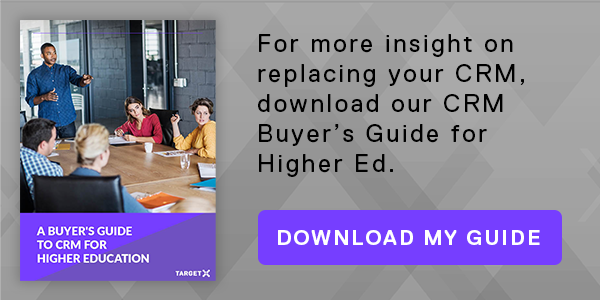By: Nicole Baldassarre, CRM Consultant @ TargetX
Is your admissions CRM truly working for you, or do you find yourself oftentimes working for your system? If you’ve been experiencing the latter, it’s time to consider your options. These solutions are designed to make your life easier, not harder, that way you can minimize administrative tasks and maximize time spent recruiting and engaging students.
It’s no secret that it’s harder today than ever before to successfully recruit students. The reality is that enrollment goals are growing while the prospective student pool (and corresponding budget dollars) are shrinking. It’s important for institutions to keep an edge in order to stay competitive, which means knowing when to let go of strategies or solutions that aren’t taking us where we need to be in redesigning the student experience.
>> Get your copy of our eBook: Redesigning the Student Experience, for more on this!
Take a look at the scenarios below. If you can relate to one or more, it’s time to upgrade your admissions CRM.
1. Your student-facing applications, inquiry forms, or event registration interfaces are dated.
Okay, so we all know that you’re subscribed to admission drip campaigns from your top competitor institutions and check out their websites every other month. But, when’s the last time you secret-shopped your own university?
From the 2018 Social Admissions Report, we know that over 75% of students engage with schools through their smartphone first. Try googling your school and register for an upcoming event as any prospective student would—or better yet, start the online application process—and take note of what that experience is like. Are your highest converting pages easily accessible, and are they mobile friendly? Or, do students have to click through multiple pages to find where to apply and pinch-and-zoom to fill out your forms?
2. Your data is inaccurate because it’s scattered across disparate systems.
If you have to wash your hands every time you pull a report from your CRM because you know your system’s data is that dirty, know you’re not alone. Four in ten admissions professionals surveyed admit they cannot access the data they need to make informed marketing and enrollment decisions. Data collection processes, departmental silos, and the need for better reporting tools are cited as the most common barriers to access.
Another indication of poor CRM hygiene is the amount of manual data entry occurring within your office. If your admission counselors are tasked with manually logging their emails and calls, your engagement data is unreliable — because at the end of the day, we’re only human and humans make mistakes. Likewise, if you have to manually alter reports on recruitment activities because you have redundant data entered in multiple formats (think: New York, NY, N.Y.), your data isn’t reliable either. Luckily, modern systems help eliminate human error with seamless contact imports, auto-completion of student records, instant activity logging, and built-in deduplication tools.
Pro-tip: If your institution’s own online application is housed outside of the CRM — why? There are so many benefits to an all-in-one approach. Aside from the initial cost savings from eliminating your application vendor by moving this area to your CRM provider, you’ll have better, cleaner data at your fingertips. Instead of waiting until a student hits “SUBMIT” on their application, you will receive a student’s contact information in real-time, as it’s entered.
3. Automation is a distant dream rather than a day-to-day reality.
Do you find yourself saying “set it and forget it” in your sleep? Automation doesn’t only have to exist in your dreams. With modern CRMs today, you can make it a reality.
Automatic activity logging, student engagement tracking, custom notifications, reminders, and specific features for certain roles are standard functionality. This means less time spent in the weeds and more time making an impact on the lives of your students.
And let’s not forget about the beauty of automated communications — it’s now possible to trigger communication plans and nurture campaigns based on enrollment criteria that you set. For instance, if a prospect attends an information session for a specific program, an email drip campaign could automatically launch providing more information on that program to encourage that student to apply. Not only does this save staff time, but it improves the student experience by delivering personalized, relevant messaging at the right time — making students really feel known by your institution.
4. Overall staff adoption is low and frustration is high.
If you see your faculty and staff working around the system by using excel spreadsheets, dropbox, or even paper files, your current CRM is holding your team back instead of inspiring growth. User adoption is the foundation to a successful implementation of any major technology solution. And, if you’re doing it right, you’ll never be done implementing your CRM! Yes, you heard that right — as your vendor releases new updates and functionality, your team should be continuously evaluating and refining its processes.
So, if your current system makes you *eyeroll* upon login, either because it’s an unstable, buggy software in which features don’t consistently work, or it has a generally clunky user experience, it’s time to upgrade.
Pro-tip: If training is an issue, compare new vendors based on their implementation and on-boarding approach. You may need to pay extra for it, but the higher baseline of expertise it grants your team, and the resulting improvements in data integrity and productivity are well worth the investment.
5. Your system won’t allow you to think outside of the box.
If your vendor doesn’t think outside of the box when it comes to their industry vision or product roadmap, chances are you’re using a system that’s not built to support innovation, either. It’s important to use a CRM with scalability — one that can grow alongside, and even beyond, your office.
This also means that your CRM should play nice with others as you come along new tools you’d like to incorporate into your admissions technology stack. Seamless integration with third-party applications is a strong sign of a scalable solution.
Scalability is also apparent in solutions that empower users to make changes and refine strategies according to your own agenda. Gone are the days of having to contact your vendor to make edits to your online application or events forms, and waiting weeks before seeing those changes. A modern CRM encourages you to own every piece of the student journey.
6. You can’t measure the ROI of your admissions activities.
The term ROI gets thrown around a lot in higher ed. But, do you actually have a dashboard configured that provides a clear picture of progress toward your enrollment goals? Or, are you still having to cobble together v-lookups and pivot tables in an Excel doc outside of your system to make “informed” decisions?
This is where things start to feel like inception — the return on your CRM investment is in its ability to uncover the ROI of your admissions activities. Wouldn’t you like to know if that open house you’ve been running on that same Saturday for the last ten years is actually driving applications? In a modern CRM, at the event-level, you can see how event attendance contributes to applications for your current and subsequent enrollment cycles. From there, you can even drill down into the other touch points that influenced how those attendees progressed through your funnel. There’s nothing quite like having attribution data at your fingertips when going into your Monday morning meeting.
If any of these scenarios are applicable to you, know that there is a light at the end of the tunnel. Implementing a new CRM may seem like a heavy lift at first, but the cost of staying in your current solution and falling further behind will be far greater than the cost of making a change. Plus, you’ll alleviate a lot of the frustrations you’re experiencing today with a more modern, robust system that energizes and empowers your team to better serve students.

